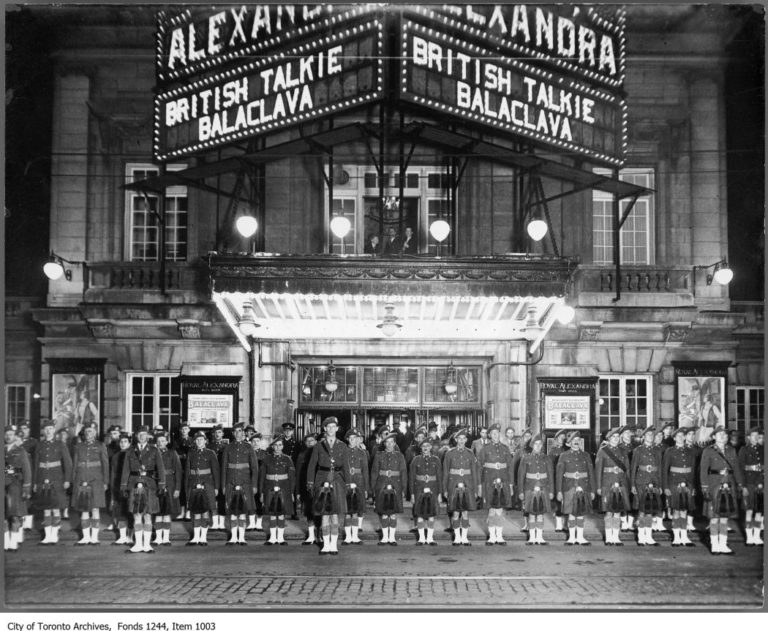A Brief History of King St. West and the Entertainment District
August 12, 2015

Thanks to the annual Toronto International Film Festival, Roy Thompson Hall and the historic Princess of Wales and Royal Alexandria theatres, the aptly named Toronto Entertainment District has become synonymous with the entertainment industry in Canada. But this vibrant beacon of culture has not always been as it stands today.
Bound by Bay St. to the east and Spadina Ave. on its western face, the Entertainment District’s nucleus runs down King St. West and features countless dining, nightlife, shopping and cultural experiences along its way. One of the oldest streets in Toronto, King St. was named after the reigning King George III, back when the city was still known as York. However, the area didn’t begin to take on a distinctive character until the early 20th century.
Before the bustling, metropolitan neighbourhood that it is today, the Entertainment District was primarily home to textile manufacturers and warehouses that supported the nearby railyards.
Although these industries held strong in the area for over half of the 20th century, by the 1960s they had begun the process of moving out. CN had begun to move their railyard operations to the northern suburb of Vaughan. What could have been an inglorious end to the district was staved off by the 1963 purchase of the historic Royal Alexandra theatre by Ed Mirvish.
Over the next decade, Mirvish would restore the Royal Alexandra to its former grandeur and host a series of touring shows on its stage. He would also purchase neighbouring buildings along the King St. West stretch that came up for sale and open a series of restaurants. These motions from Mirvish proved to be a successful bid to revitalize the district; people returned to the area and a virtual renaissance flourished.

The CN Tower was built in 1976 and brought with it international attention and tourists. This year also saw the very first Festival of Festivals, which would later be renamed as the Toronto International Film Festival. Over the course of the 80s and 90s, the Entertainment District boomed. In 1981, David Assoon and his brothers opened the Twilight Zone—Canada’s first large-scale dance club. The club’s success inspired others to follow suit, and before long, the Entertainment District was home to one of the largest concentrations of nightclubs in North America.
In 1982, Roy Thomson Hall opened up at King and Simcoe, and has hosted the Toronto Symphony Orchestra ever since. The Metro Toronto Convention Centre was built on the old railway lands and opened its Front St. doors in 1984.
1989 brought the SkyDome (later renamed the Rogers Centre), the Toronto Blue Jays and hordes of devoted sports fans. In 1993, the Mirvish family built another theatre along King St—the Princess of Wales Theatre—that could hold an audience of 2000 people and better accommodate the neighbourhood’s demands. 1999 saw the opening of Festival Hall and the early 2000s ushered in Toronto’s condo boom.
In spite of the construction boom that the Entertainment District experienced from the 80s onwards, King St. West was undergoing a period of decline. With the textile and railyard industries moving out, warehouses were left shuttered and empty. What changed the course for King St. West was a simple but transformative initiative by the city.
In the mid-90s, Barbara Hall, the mayor at that time, met with Jane Jacobs (as she often did) to discuss a strategy to revitalize the area. From these consultations, Hall and the chief city planner, Paul Bedford, developed a plan they called ‘the 2 Kings.’ This scheme saw the areas of King St. near Spadina and Parliament rezoned. Instead of only being zoned for heavy industry, they were now zoned for residential and commercial purposes.
Now magazine reported that in 1996, the number of residents that called the area home was 750. By 2005 that number had increased ten fold to 7,500 residents, and continues growing today.
Nowadays, the clubs that once lined the streets have disappeared, replaced by inventive and upscale restaurants, creative arts buildings (like 401 Richmond and the TIFF Lightbox theatre) and a swelling of new condos (soon to be joined by Mirvish+Gehry).
Though its changed faces a few time overs the years, residents have consistently been drawn to the District because of its central location, the neighbourhood vitality and entrenched culture of entertainment. With several more projects in the works for the area, it’s hard to say for sure what it will look like a few years, but if history is any indication, it’s going to be exciting.

